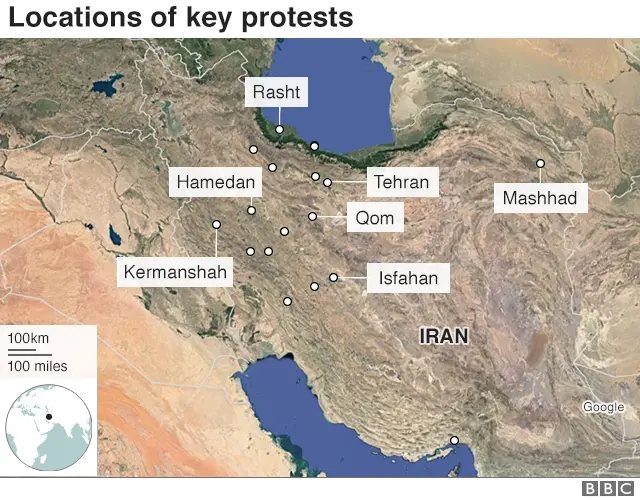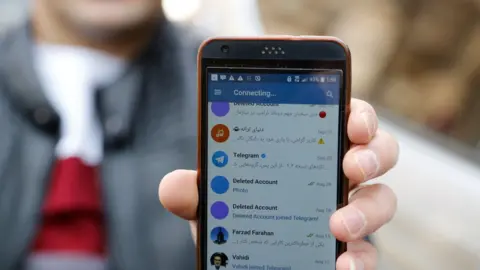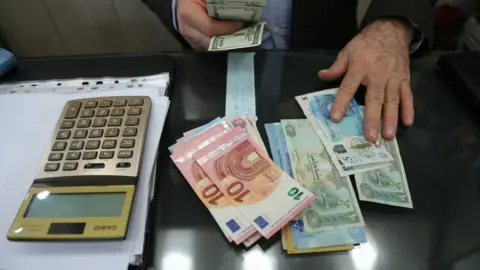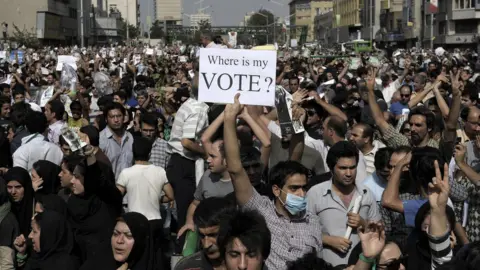Iran protests: Why is there unrest?
People have taken to the streets in cities across Iran to protest against economic hardship and political repression.
The demonstrations are the biggest in the country since 2009, when millions demanded the re-run of a disputed presidential election.
How widespread is the unrest?
Demonstrations started in Iran's second city of Mashhad on Thursday, when hundreds of people protested against high prices of basic goods.
Since then, they have spread to some 50 cities and towns, including the capital Tehran, and seen tens of thousands of people take to the streets to vent their anger at the entire establishment.
The protests turned violent in a number of locations and state media report that at least 21 people have been killed in clashes with security forces. Hundreds have also been arrested.

What do the protesters want?
The demonstrations were initially about the failure of President Hassan Rouhani's government to revive Iran's struggling economy, address high unemployment and inflation, and combat alleged corruption.
Protesters also asked why the country was spending a lot of money on conflicts elsewhere in the Middle East when people were suffering at home.
 Reuters
ReutersBut quickly the protesters moved on to politics, criticising leading figures in the Islamic Republic. In Tehran on Sunday, people chanted "death to the dictator" - an apparent reference to Supreme Leader Ayatollah Ali Khamenei.
Some have even called for a return to the monarchy that was overthrown in 1979.
How have the authorities responded?
Security forces initially appeared to show a degree of restraint. The protesters in Mashhad on Thursday were dispersed with water cannon and a small number of people were arrested. But as the protests spread, the clampdown intensified.
Mr Rouhani - a moderate who agreed a deal with world powers in 2015 to limit Iran's nuclear programme in return for the lifting of economic sanctions - said on Sunday that Iranians were "absolutely free to criticise the government and protest".
 EPA
EPABut he also warned that security forces would "show no tolerance for those who damage public properties, violate public order and create unrest in the society".
Mr Rouhani said resolving Iran's problems would "take time" and called on people to help the government, but his appeal failed to calm the situation.
 EPA
EPAReformists and conservatives have blamed each other and foreign powers for sparking the unrest.
On Tuesday, Ayatollah Khamenei said "enemies of Iran" were using their "money, weapons, politics and intelligence services to trouble the Islamic Republic".
The authorities have also blocked access to social media websites and the messaging app Telegram, which is used by millions of Iranians, in an attempt to stop calls for protests and the sharing of videos and photographs online.
Who are the protesters?
The range of slogans suggests a variety of groups are taking part and this seems to be a movement without national leaders. But so far many of the protesters appear to have been poor, unemployed people who are struggling to feed their families.
 Reuters
ReutersA recent BBC Persian investigation found that on average, Iranians have become 15% poorer over the past decade, and that their consumption of bread, milk and red meat has decreased by between 30% and 50%.
The official unemployment rate is 12.4%, but in some parts of the country it is more than 60%, according to Interior Minister Abdolreza Rahmani-Fazli. Young people - more than half of the population is under 30 - are affected particularly badly.
President Rouhani, who won re-election in May, promised that the nuclear deal would revive the economy. Yet growth has been too slow for many Iranians, who suffered years of austerity while sanctions were imposed. Many also say they cannot cope with further welfare cuts and price rises.
How is this different to 2009?
The protests are the most serious and widespread expression of public discontent in in Iran since the disputed re-election of then President Mahmoud Ahmadinejad.
 AFP
AFPMillions of people took to the streets to demand a re-run amid allegations of widespread fraud. However, Ayatollah Khamenei insisted the result was valid and ordered a crackdown on dissent that saw dozens of opposition supporters killed and thousands detained. Most of the protesters were educated, urban youths who wanted their votes to be counted.
The unrest eight years ago was also centred on Tehran. This time, demonstrations are taking place across the country.
How has the international community reacted?
US President Donald Trump has expressed his support for the protests in a series of tweets. On Monday, he wrote that Iranians were "hungry for food & for freedom", adding that it was "time for change".
The European Union said it was monitoring the situation and that it expected Iranians' rights to peaceful assembly and freedom of expression to be guaranteed.
